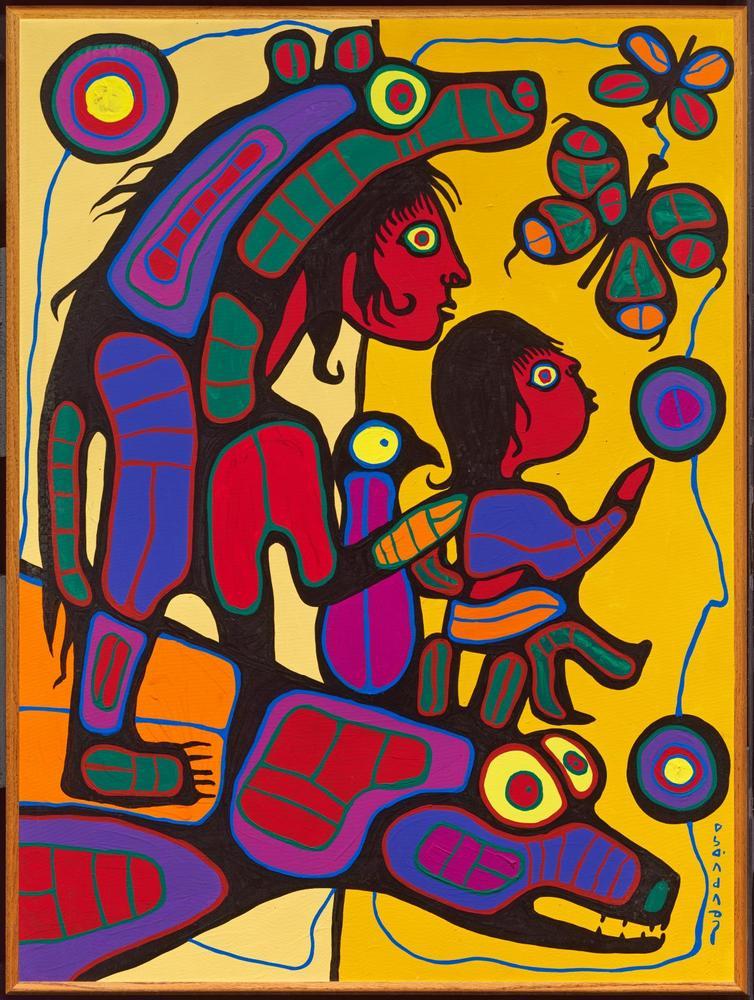Advanced Search 

Bear Father, Bear Son
Norval Morrisseau (Anishinaabe, 1931 – 2007)
1989
Medium/Technique
Acrylic on canvas
Dimensions
Length x width: 121.9 × 91.4 cm (48 × 36 in.)
Credit Line
The Betty Mayland Ellis Fund for Canadian Paintings
Accession Number2021.785
ClassificationsPaintings
Morrisseau is the most influential First Nations artist to work in a tradition of western painting. Raised on the Sand Point Reserve in northwestern Ontario, he learned traditional Anishinaabe stories, cultural practices, and pictography from his grandfather, a noted community leader and shaman. After surviving residential school and prolonged illnesses, Morrisseau received the name Miskwaabik Animiiki (Copper Thunderbird, the name he later used to sign his paintings in Cree syllabics) and began to sell his drawings on birch bark. Despite the controversies of sharing knowledge outside of the community, Morrisseau sought to visualize Anishinaabe oral histories - origin stories, connections between humans and animals, and the powers of the natural world. As his artistic practice developed, he increasingly encountered western art and media through Ontario-based artist and collectors; his interest in Picasso inspired others to describe him as "the Picasso of the North." In 1962, Morrisseau held groundbreaking solo exhibition at the Pollock gallery in Toronto, making him the first Indigenous artist to show his work in a modern art gallery in Canada. His reputation continued to grow throughout the 1970s: he was featured in two documentary films, he exhibited internationally, he was a key member of the so-called "Indian Group of Seven", and was appointed to the Order of Canada. in 1989, the same year that he completed Bear Father, Bear Son, and Morrisseau was included in the pivotal exhibition Magicians de la Terre at the at Centre Georges Pompidou in Paris. Morrisseau’ s mature compositions, with their flowing black outlines, swelling circular forms, and vibrant colors, have inspired generations of First Nations artist. He is widely considered the founder of the Woodland School of art, and the Mishomis, or grandfather, of contemporary Indigenous art in Canada.
Morrisseau once described Bear Father, Bear Son as, "Bear Gives Knowledge to Man. Man Gives Knowledge to Son," suggesting themes of kinship and transformation in this painting. Against a symmetrical, yellow background, calligraphic blue lines unite humans, animals, insects, and orbs. Their bodies, filled with blocks of brightly colored geometrical shape, to slip tonto each other, making it difficult to see where one figure begins and the other ends, The bear, depicted with wide eyes and pointed teeth, seems to support the other beings on his back, who turn towards the butterflies in the upper right. Bears are broadly related to Anishinaabe cosmologies and family organizational structures, and they were particularly significant to Morrisseau, who has personal connections to bears through spiritual experiences. The first owner of this painting, Nuu-chah-nulth artist Joe David, was drawn to it because he too has a family history of bear medicine, of spiritual power. David purchased Bear Father, Bear Son from a Vancouver exhibition in 1989; the painting drew attention in a local review, the show marked comeback iMorrisseau’s’s career, which was marked by periods of alcoholism. Morrisseau became a mentor to David, a master carver whose work is included in the MFA's collection. Among its many meanings, Bear Father, Bear Son demonstrates a powerful relationship and shared knowledge between these two important First Nations artists.
Morrisseau once described Bear Father, Bear Son as, "Bear Gives Knowledge to Man. Man Gives Knowledge to Son," suggesting themes of kinship and transformation in this painting. Against a symmetrical, yellow background, calligraphic blue lines unite humans, animals, insects, and orbs. Their bodies, filled with blocks of brightly colored geometrical shape, to slip tonto each other, making it difficult to see where one figure begins and the other ends, The bear, depicted with wide eyes and pointed teeth, seems to support the other beings on his back, who turn towards the butterflies in the upper right. Bears are broadly related to Anishinaabe cosmologies and family organizational structures, and they were particularly significant to Morrisseau, who has personal connections to bears through spiritual experiences. The first owner of this painting, Nuu-chah-nulth artist Joe David, was drawn to it because he too has a family history of bear medicine, of spiritual power. David purchased Bear Father, Bear Son from a Vancouver exhibition in 1989; the painting drew attention in a local review, the show marked comeback iMorrisseau’s’s career, which was marked by periods of alcoholism. Morrisseau became a mentor to David, a master carver whose work is included in the MFA's collection. Among its many meanings, Bear Father, Bear Son demonstrates a powerful relationship and shared knowledge between these two important First Nations artists.
ProvenanceBy 1989, sold by The Art Emporium Gallery, Vancouver to Joe David, Tofino, British Columbia, Canada; 2021, sold by Joe David to the MFA. (Accession date: December 15, 2021)
CopyrightAuthentication & Permission granted by the Estate of Norval Morrisseau. OfficialMorrisseau.com.
